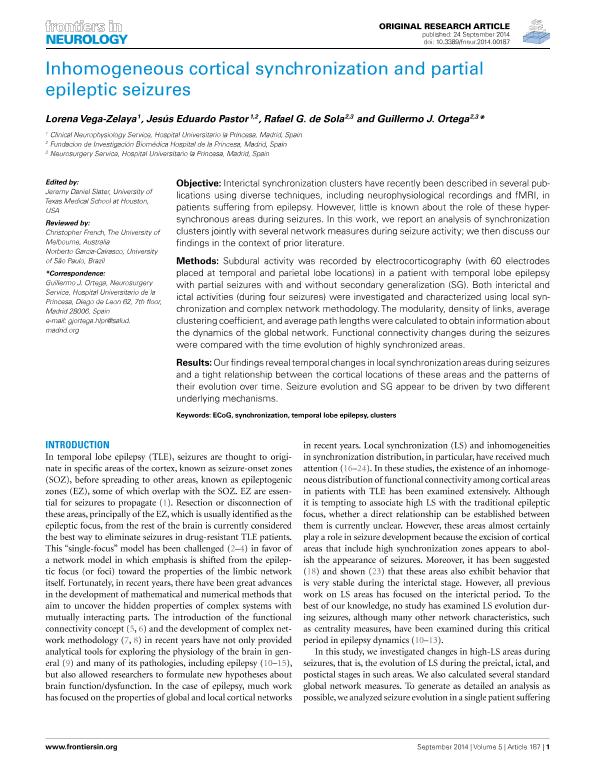Artículo
Inhomogeneous cortical synchronization and partial epileptic seizures
Fecha de publicación:
09/2014
Editorial:
Frontiers Media S.A.
Revista:
Frontiers in Neurology
ISSN:
1664-2295
Idioma:
Inglés
Tipo de recurso:
Artículo publicado
Clasificación temática:
Resumen
Objective: Interictal synchronization clusters have recently been described in several publications using diverse techniques, including neurophysiological recordings and fMRI, in patients suffering from epilepsy. However, little is known about the role of these hypersynchronous areas during seizures. In this work, we report an analysis of synchronization clusters jointly with several network measures during seizure activity; we then discuss our findings in the context of prior literature.Methods: Subdural activity was recorded by electrocorticography (with 60 electrodesplaced at temporal and parietal lobe locations) in a patient with temporal lobe epilepsywith partial seizures with and without secondary generalization (SG). Both interictal andictal activities (during four seizures) were investigated and characterized using local synchronization and complex network methodology. The modularity, density of links, average clustering coefficient, and average path lengthswere calculated to obtain information about the dynamics of the global network. Functional connectivity changes during the seizures were compared with the time evolution of highly synchronized areas.Results: Our findings reveal temporal changes in local synchronization areas during seizuresand a tight relationship between the cortical locations of these areas and the patterns oftheir evolution over time. Seizure evolution and SG appear to be driven by two differentunderlying mechanisms.
Palabras clave:
EEG
,
CLUSTERS
,
TEMPORAL LOBE EPILEPSY
,
COMPLEX NETWORKS
Archivos asociados
Licencia
Identificadores
Colecciones
Articulos(SEDE CENTRAL)
Articulos de SEDE CENTRAL
Articulos de SEDE CENTRAL
Citación
Vega Zelaya, Lorena; Pastor, Jesús Eduardo ; García de Sola, Rafael; Ortega, Guillermo José; Inhomogeneous cortical synchronization and partial epileptic seizures; Frontiers Media S.A.; Frontiers in Neurology; 5; 187; 9-2014; 1-11
Compartir
Altmétricas




